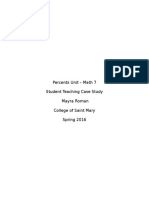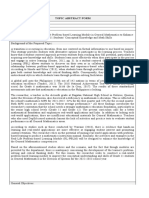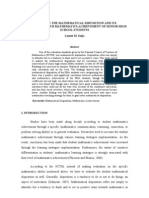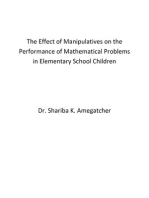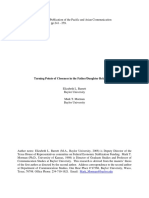0 ratings0% found this document useful (0 votes)
109 viewsBowenr Ka
Uploaded by
api-256264104Copyright
© © All Rights Reserved
Available Formats
Download as DOCX, PDF, TXT or read online on Scribd
0 ratings0% found this document useful (0 votes)
109 viewsBowenr Ka
Uploaded by
api-256264104Copyright
© © All Rights Reserved
Available Formats
Download as DOCX, PDF, TXT or read online on Scribd
You are on page 1/ 17
Rebekah Bowen Key Assessment FRIT 7231
Identification of a Learning Problem
Target Audience
My target audience for this assessment is 7
th
grade math students. More specifically, the
students in the 7
th
grade math classes who struggled with the 6
th
grade standard of understanding
and solving one-step equations. These students have been observed in 6
th
grade math
classrooms, and data has also been collected from standardized assessments. These students
have been described as immature for their age and have a lack of motivation as well as support at
home.
Identification of Problem
The problem that has been identified is the lack of understanding students currently have
with the process and the purpose of solving one-step and multi-step linear equations. This
problem was identified through vertical alignment meetings within our middle school as well as
vertical alignment meetings with 9
th
grade math teachers. Middle and high school teachers
expressed a concern for the use of a consistent process and stressed the importance of key
vocabulary terms (i.e. inverse operation, coefficient, variable, etc.) when teaching students to
understand the how and why of solving equations. Teachers were especially concerned with
the students who could struggle through solving an equation, but had no idea why they were
doing it or what the final answer meant in terms of the variable.
The needs assessments conducted were a felt needs assessment and an anticipated needs
assessment. The felt needs assessment was derived from the feelings of the math teachers in the
discussions regarding the level of understanding the students currently possess when solving
equations. The anticipated need comes when thinking about future math classes and the level of
understanding the students will need in the courses to come. In high school level courses as well
as 8
th
grade math, students will be required to find different types of solutions to many different
types of equations. Without a full understanding of solving one-step, two-step, and multi-step
equations, students will continue to struggle for years to come.
Goal of Instruction
Rebekah Bowen Key Assessment FRIT 7231
The goal for the 7
th
grade math unit on multi-step linear equations is that students will be
able to demonstrate their knowledge of solving multi-step equations. They will demonstrate this
knowledge in the following ways: 1) they will correctly identify the vocabulary associated with
equations such as variable, coefficient, and inverse operation; 2) they explain and use the steps to
solve an algebraic equation; 3) they will apply their knowledge by creating and solving an
algebraic equation for a real-world situation; and 4) they will evaluate fellow classmates real-
world algebraic equations for accuracy and plausibility.
Learner Analysis
Introduction
The learners in this 7
th
grade class are made up of 59% girls and 40% boys, 59%
White/non-Hispanic, 36% Black/non-Hispanic, and 4% Asian. 77% of students are labeled as
economically disadvantaged, and only 4% are students with disabilities. The demographic
information for this learner analysis was obtained by using the Statewide Longitudinal Data
System (SLDS). The SLDS also provides some knowledge of entry skills and prior knowledge
that students may possess based on previous years Criterion Referenced Competency Test
(CRCT) scores and Lexile scores. In order to obtain the needed information for these upcoming
7
th
grade students, the data that was collected was regarding this classs 6
th
grade test scores.
Teacher observations and interviews were also conducted in an attempt to gain information for
the learner analysis.
Entry Skills and Prior Knowledge
After viewing the SLDS scores, I was able to determine that most of the students in the
class could adequately display their skills on standardized tests. Of the students in this typical 7
th
grade class, 13% did not meet the required score on the math portion of the CRCT their 6
th
grade
year. Focusing particularly on the algebra section of the test, only one student scored less than
50% correct. There were six students who scored more than 80% correct on the algebra section
of the CRCT and four of these students exceeded the entire math section of the test.
Contrastingly, there were 27% of this particular class that failed math for the year which,
appropriately leads to the next section.
Attitudes Toward Content & Academic Motivation
Rebekah Bowen Key Assessment FRIT 7231
The students in this particular math class showed a great deal of prior knowledge as
shown in their CRCT scores, but after interviewing this class 6
th
grade teachers, the students
have a severe lack of motivation to understand the why in algebra. For example, they may be
able to solve the simple one-step equations, but could not explain why x=6. The teachers tried
many different strategies to make understanding equations more fun. Some students caught
on, but there were many who still did not show any interest in learning why; they simply wanted
to state that x=6. The teachers were very discouraged when students did not show the skills
needed to pass tests and complete homework during the school year, but then pass a state test.
Do not misunderstand, they were proud of their students for doing well, but the discouragement
comes from the students lack of motivation to use any of the skills they obviously possess
during the year.
Educational Ability Levels
Lexile scores were obtained through the SLDS showing 31% of the class reading below
the 7
th
grade level. In interviews with 7
th
grade teachers it was commented that this is a typical
statistic of most 7
th
grade classrooms. On the other hand, there were 53% of the students reading
above a 7
th
grade level. These scores indicate that the majority of the students have the
necessary ability to read the material presented to them in the 7
th
grade math classroom.
According to the teacher interviews, quite a bit of the students still had difficulty with new
vocabulary, especially algebra vocabulary, and suggested that specific emphasis be placed on
strategies for learning content vocabulary.
General Learning Preferences
There are a variety of learning styles within this 7
th
grade classroom. After interviewing
previous teachers, it was discovered that there was not a great deal of emphasis placed on the
learning styles of students. Some of the teachers have students complete an introductory
questionnaire at the beginning of the year in which students have the opportunity to disclose any
important information about past learning experiences or describe what type of environment they
learn best in (i.e. quiet, silent, doesnt matter). In this questionnaire, the teachers ask the students
how they prefer the teacher to present new material (i.e. handouts, lecture, PowerPoints, or all of
the above). Only 10% of the students reported that they learned best from lecture. 46% of the
students said they liked to watch the teacher do an example of an algebra problem, and then let
Rebekah Bowen Key Assessment FRIT 7231
them try. 26% of the students said they like to hear the teacher describe how to work the
problem, watch them work the problem, have a graphic organizer to look at, and then try a
problem on their own. The last 18% of the students either did not have appropriate responses or
did not answer the question being asked. The teachers report that they look over these
questionnaires, and that they try their best to incorporate many types of materials throughout the
lessons so that students have every type of learning style presented.
Attitude Toward Teachers and School
In the teacher interviews, when attitudes of the students were discussed, it was not a
bright spot in the process. Teachers were disheartened by the attitudes of students towards
teachers and especially school in general. Homework has been a topic of discussion throughout
the school year in the math department. Many of the students who failed math for the year did so
because of homework grades. Many math teachers have stopped giving homework altogether
because students do not see the importance of it and do not care that they will get a zero for not
completing it and therefore have multiple zeros resulting in failing averages. Many of these
particular students come from economically disadvantaged homes where there is no one at home
supporting them and encouraging them to do well in school and students therefore see no value
in their education.
Group Characteristics
Overall, this group of 7
th
graders is consistent with an average class at the same academic
level. The 6
th
grade teachers who were interviewed described these students as a little more
immature than usual. There was a great deal more focus on who said what to whom than on
math concepts being presented by the teachers.
Task Analysis
Method
I analyzed the task that would be the focus of the students in this unit, along with the
Subject Matter Expert (SME), and it was decided that we would use the procedural method to
conduct the task analysis. Solving multi-step linear equations is a very procedural process in
which you have distinct steps that must be completed in a particular way in order to obtain the
Rebekah Bowen Key Assessment FRIT 7231
correct solution to the equation. The learner must first identify parts of the equation which
would require knowledge of the vocabulary. Second, the learner must decide if there are any
preliminary steps that need to take place before actually solving (i.e. combining like terms,
moving variables to one side, using distributive property). Then, the learner will begin working
through the steps to solve the equation. Lastly, the learner must substitute the solution into the
original equation to check that it satisfies the equation.
Interaction with Subject Matter Expert
I spoke with a subject matter expert (SME), but consider myself to be an SME as well
because I have taught solving equations for many years. My fellow SME has taught math for
three years in the middle school setting and has worked with regular education students,
inclusion students, and students in a resource math classroom. In discussing teaching strategies
for solving equations, we both felt that there were distinct procedures that students should follow
in order to properly assess and solve an equation.
Procedural Analysis
The SME and I answered the following questions in our procedural analysis of solving
multi-step equations.
1. What does the student do when solving equations?
Perform inverse operations to isolate the desired variable.
They will need to add, subtract, multiply, and/or divide rational numbers.
2. What does the student need to know before successful completion of multi-step
equations?
Students will need working knowledge of integer rules in order to accurately
perform inverse operations.
Students will need to visualize the equation as having two separate sides, one to
the left of the equal sign and one to the right.
3. What cues will inform the student in what order steps need to take place?
Students may see parenthesis on one or both sides of the equation which need to
be eliminated using distributive property before moving to next steps.
Students will need to look for any like terms and properly combine them.
Rebekah Bowen Key Assessment FRIT 7231
Students may also see the same variable on both sides of the equation and will
need to use inverse operations to move common variables to the same side of
the equation.
After completing this procedural analysis, the SME and I were able to create a task diagram to
better visualize the process that will be taught.
Task Diagram
Instructional Objectives
Terminal Object 1: To identify the vocabulary associated with equations
Enabling Objectives:
1a: To define pertinent vocabulary (variable, coefficient, inverse operation, etc.)
1b: To locate the vocabulary in relation to the parts of the equation
Terminal Objective 2: To explain and use the necessary steps to solve an algebraic equation
Divide the equation into
two parts separated by
the equal sign.
Assess each side of the
equation to determine
which of the following
are necessary:
Combine Like
Terms
Move like
variables to
one side
Use distributive
property
None of these
needed
Use inverse operation to
solve equation
Substitute solution to
check
Rebekah Bowen Key Assessment FRIT 7231
Enabling Objectives:
2a: Apply the steps learned to solve for the missing variable of the equation
2b: Test the solution to validate that it is the correct solution
2c: Interpret the meaning of the solution
Terminal Objective 3: To apply knowledge of equations
Enabling Objectives:
3a: Create an algebraic equation based on a real-world scenario
3b: Solve the created equation
3c: Judge whether the solution is valid
Terminal Objective 4: Evaluate fellow classmates real-world algebraic equations for accuracy
and plausibility.
Enabling Objectives:
4a: Compare student equations to created real-world scenarios
4b: Rate student scenarios and equations
Classification of Instructional Objectives
Content
Performance
Recall Application
Fact 1a, 1b
Concepts 3c
Principles
Procedures 2a, 2b 2, 3
Interpersonal 2c, 4a, 4b 4
Rebekah Bowen Key Assessment FRIT 7231
Attitude
Relationship between Instructional Objectives and Standards:
Instructional Objective CCGPS
1 All expression and equations standards
1a
1b
2 7.EE.3 Solve multi-step real-life and
mathematical problems posed with positive
and negative rational numbers in any form,
using tools strategically. Apply properties of
operations to calculate with numbers in any
form; convert between forms as appropriate;
and assess the reasonableness using mental
computations and estimation strategies.
2a
2b
2c
3 7.EE.4a Solve word problems leading to
equations in the form of px + q = r and p(x +
q) = r where p,q, and r are specific rational
numbers. Solve equations of these forms
fluently. Compare an algebraic solution to an
arithmetic solution, identifying the sequence
of the operations used in each approach.
3a
3b
3c
4 7.EE.4 Use variables to represent quantities in
a real-world or mathematical problem and
construct simple equations to solve problems
by reasoning about the quantities.
4a
4b
Rebekah Bowen Key Assessment FRIT 7231
Development of Assessment and Design of Instruction (Part 5 and Part 7)
Strategy: Goals Objectives Assessments UDL
Stations 1 1a, 1b Students will need to post one thing
that the stations helped them to
remember and respond to a
classmates post.
Students will have a choice in the
problems they choose to work.
Learnzillion
Videos
2 2a, 2b, 2c One type of presentation using
video
Guided Notes 2 2a, 2b
TIP Chart 1 1a, 1b This will be a visual for students
to keep handy or even print out if
they wish.
Prezis 2 2a, 2b, 2c At the end of the lesson
presentation, students will complete
a formative assessment by solving a
multi-step equation and submitting
via MyBigCampus.
Second type of presentation of
material which they can interact
with.
Ixl practice 2 2a, 2b This will be a formative assessment
where students will complete
several online practice problems.
Algebralab
webpage
3 3a, 3b, 3c Instruction through text material
MyBigCampus
Video
3 3a, 3b, 3c Instruction through video
Cooperative
Groups
1, 2, 3, 4 1a, 1b, 2a,
2b, 2c, 3a,
3b, 3c, 4a,
4b
Formative assessment where
student groups create scenarios
based on the equations they solved
in the previous lesson
Students will be able to create
stories that relate solving
equations to personal interests.
Khan Academy
practice
3 3a, 3b, 3c Formative assessment for students
with immediate feedback provided
through site.
Scaffolding is provided
throughout the practice
Rebekah Bowen Key Assessment FRIT 7231
Group Prezis 3, 4 3a, 3b, 3c,
4a, 4b
Summative assessment in which
students will be graded based on the
creativeness and accuracy of the
presentation.
Groups will be allowed to choose
which type of presentation
format they prefer.
Carousel 4 4a, 4b Summative assessment where
students are graded according to
their responses and work of the
other groups equations.
MyBigCampus
Discussions
1, 2, 3, 4 1a, 1b, 2a,
2b, 2c, 3a,
3b, 3c, 4a,
4b
Formative assessments will be
given throughout the unit through
the discussion boards in which each
student will be expected to respond.
Lesson 1 Assessments:
At the end of day 1, students will solve the following multi-step equation: 3(5 + d) = 36 in a discussion post on MyBigCampus.
The following problems will be completed as an assessment during day 2 of lesson 1.
1. Solve for s. 2 = 6 2s
2. Solve for u. 2u 4 = 4
3. Solve for z. 2z 5 = 3
4. Solve for s. 6 2s = 4
5. Solve for d. 3d 3 = 15
6. Solve for z. z/3 1 = 3
7. Solve for c. 3c + 5 = 14
8. Solve for t. 12 = 14 2t
9. Solve for f. f/10 + 85 = 90
10. Solve for c. (c 55) / 3 = 9
1. Solve for v. 11v v = 10
2. Solve for p. 16p 11p = 20
3. Solve for p. 6p 3p = 9
4. Solve for k. 8k 4k = 20
5. Solve for c. c + 5c = 12
6. Solve for b. 8b 5b = 18
7. Solve for n. 14n + 5n + n = 20
8. Solve for c. 3c + c + 3c 2c 2c = 9
9. Solve for n. 19n + 2n 19n = 18
10. Solve for h. 10h 9h h + 2h = 20
Rebekah Bowen Key Assessment FRIT 7231
Lesson 2 Assessments:
Students will use the equations from the previous lesson to create word problems based on
scenarios they create. Below is an example of one such word problem.
Equation from lesson 1 practice: 3c + 5 = 14
Word problem: Daniel has $5 in his piggy bank. He wants to buy a new video game that cost
$14. Each day that he does all his chores, his mother gives him $3. How many days will he
have to complete his chores before he will have enough money to buy his video game?
Students will work to create several word problems during this part of the lesson.
Students will now complete Khan Academy practice where they will write and solve equations
based on the word problems they are given.
Example: Sarah sells magazine subscriptions and earns $4 for every new subscriber she signs
up. Sarah also earns a $38 weekly bonus regardless of how many magazine subscriptions she
sells. If Sarah wants to earn $91 this week, how many subscriptions does she need to sell?
Final Assessment:
Below is a link to the exemplar for the final group presentation. The exemplar is a Prezi, but
students will be allowed to choose a different format to present in such as Microsoft Word or
PowerPoint.
http://prezi.com/unjqnqfet2-a/?utm_campaign=share&utm_medium=copy&rc=ex0share
Assessment Rubric:
Below is the rubric that will be used to grade the final projects. Students will be given this rubric
before they begin their final project in order for them to know exactly what will be expected.
Multimedia Project : Equation Creation Project
Teacher Name: Mrs. Bowen
Student Name: ________________________________________
CATEGORY 4 3 2 1
Content Covers topic in-
depth with details
and examples.
Subject
knowledge is
excellent.
Includes essential
knowledge about
the topic. Subject
knowledge
appears to be
good.
Includes essential
information about
the topic but there
are 1-2 factual
errors.
Content is
minimal OR there
are several
factual errors.
Rebekah Bowen Key Assessment FRIT 7231
Attractiveness Makes excellent
use of font, color,
graphics, effects,
etc. to enhance
the presentation.
Makes good use
of font, color,
graphics, effects,
etc. to enhance to
presentation.
Makes use of
font, color,
graphics, effects,
etc. but
occasionally
these detract from
the presentation
content.
Use of font,
color, graphics,
effects etc. but
these often
distract from the
presentaion
content.
Workload The workload is
divided and
shared equally by
all team
members.
The workload is
divided and
shared fairly by
all team
members, though
workloads may
vary from person
to person.
The workload
was divided, but
one person in the
group is viewed
as not doing
his/her fair share
of the work.
The workload
was not divided
OR several
people in the
group are viewed
as not doing their
fair share of the
work.
Mechanics No misspellings
or grammatical
errors.
Three or fewer
misspellings
and/or
mechanical
errors.
Four misspellings
and/or
grammatical
errors.
More than 4
errors in spelling
or grammar.
Assessment Differentiation:
Assessment 1) Students will need to post one thing that the stations helped them to remember
and respond to a classmates post.
Differentiation: Students will be able to pick any part of the opening activity to
comment on.
Assessment 2) At the end of the lesson presentation, students will complete a formative
assessment by solving a multi-step equation and submitting via MyBigCampus.
Differentiation: Students will not all be given the same equation. Some will be mirror
images of ones given during the lesson and others will require students to use what they
learned during the lesson to show their knowledge.
Assessment 3) This will be a formative assessment where students will complete several online
practice problems.
Differentiation: The format of this assessment will be online questions that will allow
students to work at their own pace.
Assessment 4) Formative assessment where student groups create scenarios based on the
equations they solved in the previous lesson
Differentiation: Students will be allowed to create scenarios based on their personal
interests.
Rebekah Bowen Key Assessment FRIT 7231
Assessment 5) Formative assessment for students with immediate feedback provided through
site.
Differentiation: Students will be provided with scaffolding, within the website, as
needed throughout this particular assessment.
Assessment 6) Summative assessment in which students will be graded based on the
creativeness and accuracy of the presentation.
Differentiation: Students will be allowed to choose which format they are most
comfortable with to present their knowledge of solving multi-step equations.
Assessment 7) Summative assessment where students are graded according to their responses
and work of the other groups equations.
Differentiation: Students will be graded based on their improvement throughout the
unit.
Assessment 8) Formative assessments will be given throughout the unit through the discussion
boards in which each student will be expected to respond.
Differentiation: Students will be allowed to express themselves and their thoughts
and/or questions throughout the unit. Students that feel that they fully understand the
concept may be able to respond to other students who may be struggling. This will build
a new level of understanding for the quick learners by allowing them to explain things to
others, and it will provide a different type of instruction/tutoring for students who need
extra help.
Content sequencing and Instructional Strategies
Sequence Description Objective
1 Define and identify within the equation, pertinent vocabulary 1
2 To solve and understand the solution as well as test the solution 2
3 Write algebraic equations based on a real-world scenario 3
4 Evaluate equations and scenarios developed by classmates 4
Lesson 1: Intro to Multi-Step Equations
Day 1: Try to Remember
Object 1: To identify the vocabulary associated with equations
Rebekah Bowen Key Assessment FRIT 7231
Objective 1a: To define pertinent vocabulary (variable, coefficient, inverse operation, etc.)
Objective 1b: To locate the vocabulary in relation to the parts of the equation
Motivational Strategy: Students will work with cooperative groups to complete a stations
activity. This will use review prerequisite skills as well as new vocabulary. Stations will be
given through our MyBigCampus website and will include, solving one-step equations,
combining like terms, vocabulary sort, order of operations with integers. Students will be
allowed to choose five problems to work per station. This will give the students a chance to
work problems they feel confident about in order to start the new unit with positive feelings and
hopefully motivate them to achieve the new classroom goal.
Differentiation: The differentiation within this first activity comes from the student choice in the
problems they work. Also by discussing the problems with other students, they may better
understand some of the more difficult problems that they werent comfortable choosing to start.
Day 2: The Process
Objective 2: To explain and use the necessary steps to solve an algebraic equation
Objective 2a: Apply the steps learned to solve for the missing variable of the equation
Objective 2b: Test the solution to validate that it is the correct solution
Objective 2c: Interpret the meaning of the solution
Initial Presentation: Students will watch a series of videos walking them through the steps of
solving multi-step equations. They will be required to watch the first three videos, but can also
watch the others on the site. Students will complete guided notes while watching the videos and
will add words a vocabulary TIP chart as they come to new terms in the lesson. Students will
also be assigned a Prezi that describes, interactively, the steps for solving equations. There will
be guided practice in this presentation.
Differentiation: Students will have multiple means of presentation for the lesson materials. The
videos provide more than one strategy for solving equations and will be allowed to use the
strategy they prefer when showing their work for class assignments.
Rebekah Bowen Key Assessment FRIT 7231
Video Link 1: http://learnzillion.com/lessons/1009-solve-linear-equations-by-combining-like-
terms
Generative Strategy: Students will be able to work with a partner to complete the following
online practice solving multi-step equations. They must use the steps they learned in the
introductory videos to solve for the missing variables as well as check their answers to validate
their solution.
Practice Link 1: http://www.ixl.com/math/grade-7/solve-two-step-linear-equations
Practice Link 2: http://www.ixl.com/math/grade-7/solve-equations-involving-like-terms
Lesson 2: Make Them Your Own
Day 1: In your own words
Objective 3: To apply knowledge of equations
Objective 3a: Create an algebraic equation based on a real-world scenario
Objective 3b: Solve the created equation
Objective 3c: Judge whether the solution is valid
Generative Strategy: Student groups will be given instructions to create a number of word
problems from the equations they have been solving from the previous days. They must each
create a different word problem scenario and then share their scenario through the discussion
board of MyBigCampus.
Differentiation: Groups can create any story that they like. This will give them an opportunity
for them to relate the math they are working on, not only to something that is of interest to them,
but also to a real-world situation.
Initial Presentation: Students will then access the two links below explaining the steps for
translating word problems into equations and solving:
Rebekah Bowen Key Assessment FRIT 7231
Web Link:
http://www.algebralab.org/lessons/lesson.aspx?file=Algebra_OneVariableWritingEquations.xml
Video Link 3: http://www.mybigcampus.com/library/274919
Motivational Strategy: I will post several real-world word problems for students to discuss using
the MyBigCampus discussion board. They will discuss possible ways to set up equations and
make use estimation strategies to generate a possible solution.
Differentiation: Students will be viewing videos that show different formats for translating the
word problems. One video explains the steps while the other gives the steps through text that
allows interaction.
Day 2 and 3: Tell Me a Story
Objective 4: Evaluate fellow classmates real-world algebraic equations for accuracy and
plausibility.
Objectives 4a: Compare student equations to created real-world scenarios
Objective G4b: Rate student scenarios and equations
Generative Strategy: Students will follow the link below to practice writing and solving
equations.
Practice Link 3: https://www.khanacademy.org/math/algebra/solving-linear-equations-and-
inequalities/basic-equation-practice/e/linear_equation_word_problems
Differentiation: Within this link there is immediate feedback as well as scaffolding to allow
students who still may be struggling to understand the process for creating equations from word
problems.
Generative Strategy: Students groups will then be given a task asking them to first, create a
word problem scenario (They will be allowed to do this with Microsoft Word, PowerPoint, or in
a Prezi), second, write and equation based on the information, and finally, solve the equation.
The groups will upload their presentations to allow an online carousel in which they will be
working the problems and giving the creating group feedback through the MyBigCampus
discussion board.
Rebekah Bowen Key Assessment FRIT 7231
Differentiation: Groups will be allowed to choose how they present the knowledge of multi-step
equations.
References:
Hsiung, C. (2012). The Effectiveness of Cooperative Learning. Journal of Engineering
Education. 101(1). 119-137.
Kern, L., State, T. (2009). Incorporating Choice and Preferred Activities into Class Wide
Instruction. Beyond Behavior. 18(2). 3-11.
Zimmerman, B.J., Bandura, A., & Martinez-Pons, M. (1992) Self-motivation for academic
attainment: The role of self-efficacy beliefs and personal goal setting. American Educational
Research Journal. 31. 663-676.
Formative Evaluation Plan
I will collect information from the learners in my online module throughout the unit.
With the use of our discussion board, I will be able to ask questions about learners attitudes
towards the materials. The students will also complete a survey at the end of the unit that will
ask direct questions about the delivery of the content, the accessibility of the material, and the
interaction among the class. My SME will be allowed to follow along with the class in the
module. I can open our class MyBigCampus page to the SME and they will have full access to
all instructional videos, assignments, and discussion posts.
Survey Link:
http://www.surveymonkey.com/s/W25RCM6
After students and SME have completed the survey, I will compile the data into a spreadsheet to
make it more easily organized. I will assess the answers and create a graph to visually display
the results. I will compare the results of the survey to the formative and summative assessment
data of the students from the unit. I will use the information gathered to make changes to the
unit to better suit the needs of the learners.
You might also like
- Suicide Risk Assessment Form: (Adapted From Becks Suicidal Intent Scale)No ratings yetSuicide Risk Assessment Form: (Adapted From Becks Suicidal Intent Scale)2 pages
- FACTORS_AFFECTING_THE_PERFORMANCE_OF_STUNo ratings yetFACTORS_AFFECTING_THE_PERFORMANCE_OF_STU28 pages
- Impact On Student Learning Taylor HunterNo ratings yetImpact On Student Learning Taylor Hunter13 pages
- Misconceptions and Common Errors in Solving AlgebraicNo ratings yetMisconceptions and Common Errors in Solving Algebraic14 pages
- Enhancing Basic Math Operations VocabularyNo ratings yetEnhancing Basic Math Operations Vocabulary18 pages
- Part I: Identification of Learning Problem General AudienceNo ratings yetPart I: Identification of Learning Problem General Audience38 pages
- Part I: Identification of Learning Problem General AudienceNo ratings yetPart I: Identification of Learning Problem General Audience40 pages
- It Is Not Just The Solution Anymore: Carol Brown Alliance, NebraskaNo ratings yetIt Is Not Just The Solution Anymore: Carol Brown Alliance, Nebraska54 pages
- Chapter 1 2 Solving Worded Problems Performance in Algebra of Grade 8 StudentsNo ratings yetChapter 1 2 Solving Worded Problems Performance in Algebra of Grade 8 Students18 pages
- GROUP 4 Activity 1 and Reminders For EDASSL 2No ratings yetGROUP 4 Activity 1 and Reminders For EDASSL 25 pages
- Philippine Normal University: The National Center For Teacher EducationNo ratings yetPhilippine Normal University: The National Center For Teacher Education4 pages
- Doc-20230924-Wa0007. Needs Analysis Edid6502No ratings yetDoc-20230924-Wa0007. Needs Analysis Edid650210 pages
- Orca Share Media1669512007925 7002440892888450447No ratings yetOrca Share Media1669512007925 70024408928884504472 pages
- Episode 6: Scoring, Grading and CommunicationNo ratings yetEpisode 6: Scoring, Grading and Communication6 pages
- Learners’ Difficulties and Teacher-Related Variables in Relation to Academic Achievement of Low Performing Learners in MathematicsNo ratings yetLearners’ Difficulties and Teacher-Related Variables in Relation to Academic Achievement of Low Performing Learners in Mathematics11 pages
- Analyzing The Mathematical Disposition and Its Correlation With Mathematics Achievement of Senior High School Students F JournalNo ratings yetAnalyzing The Mathematical Disposition and Its Correlation With Mathematics Achievement of Senior High School Students F Journal6 pages
- ACTION-RESEARCH REPORT by Andy & MarisarNo ratings yetACTION-RESEARCH REPORT by Andy & Marisar6 pages
- The Effect of Manipulatives on the Performance of Mathematical Problems in Elementary School ChildrenFrom EverandThe Effect of Manipulatives on the Performance of Mathematical Problems in Elementary School ChildrenNo ratings yet
- Connecting People - The Interpersonal Excellence: Tariq Ali Panjwani Asst. Manager T&ODNo ratings yetConnecting People - The Interpersonal Excellence: Tariq Ali Panjwani Asst. Manager T&OD32 pages
- Institute of Health Faculty of Health Sceince School of NursingNo ratings yetInstitute of Health Faculty of Health Sceince School of Nursing17 pages
- Too Many Job Seekers Stumble Through Interviews As If The Questions Asked Are Coming Out of Left FieldNo ratings yetToo Many Job Seekers Stumble Through Interviews As If The Questions Asked Are Coming Out of Left Field13 pages
- Daftar Pustaka: Universitas Sumatera UtaraNo ratings yetDaftar Pustaka: Universitas Sumatera Utara7 pages
- Online Learning and Learning Interest Among UM Freshmen Engineering Students100% (1)Online Learning and Learning Interest Among UM Freshmen Engineering Students32 pages
- Lesson 2 People Centered Development Management and EmpowermentNo ratings yetLesson 2 People Centered Development Management and Empowerment3 pages
- G2 Session 4 AWARENESS OF SELF AND OTHERSNo ratings yetG2 Session 4 AWARENESS OF SELF AND OTHERS11 pages
- Student Biopsychosocial Assessment For Client A FinalizedNo ratings yetStudent Biopsychosocial Assessment For Client A Finalized8 pages
- Technology Entrepreneurship (ENT600) Written Report On Case Study (20%)No ratings yetTechnology Entrepreneurship (ENT600) Written Report On Case Study (20%)5 pages
- Emotion Has A Particularly Strong Influence On Attention, Especially Modulating The Selectivity of Attention As Well As Motivating Action and BehaviorNo ratings yetEmotion Has A Particularly Strong Influence On Attention, Especially Modulating The Selectivity of Attention As Well As Motivating Action and Behavior2 pages
- Suicide Risk Assessment Form: (Adapted From Becks Suicidal Intent Scale)Suicide Risk Assessment Form: (Adapted From Becks Suicidal Intent Scale)
- Misconceptions and Common Errors in Solving AlgebraicMisconceptions and Common Errors in Solving Algebraic
- Part I: Identification of Learning Problem General AudiencePart I: Identification of Learning Problem General Audience
- Part I: Identification of Learning Problem General AudiencePart I: Identification of Learning Problem General Audience
- It Is Not Just The Solution Anymore: Carol Brown Alliance, NebraskaIt Is Not Just The Solution Anymore: Carol Brown Alliance, Nebraska
- Chapter 1 2 Solving Worded Problems Performance in Algebra of Grade 8 StudentsChapter 1 2 Solving Worded Problems Performance in Algebra of Grade 8 Students
- Philippine Normal University: The National Center For Teacher EducationPhilippine Normal University: The National Center For Teacher Education
- Learners’ Difficulties and Teacher-Related Variables in Relation to Academic Achievement of Low Performing Learners in MathematicsLearners’ Difficulties and Teacher-Related Variables in Relation to Academic Achievement of Low Performing Learners in Mathematics
- Analyzing The Mathematical Disposition and Its Correlation With Mathematics Achievement of Senior High School Students F JournalAnalyzing The Mathematical Disposition and Its Correlation With Mathematics Achievement of Senior High School Students F Journal
- The Effect of Manipulatives on the Performance of Mathematical Problems in Elementary School ChildrenFrom EverandThe Effect of Manipulatives on the Performance of Mathematical Problems in Elementary School Children
- Connecting People - The Interpersonal Excellence: Tariq Ali Panjwani Asst. Manager T&ODConnecting People - The Interpersonal Excellence: Tariq Ali Panjwani Asst. Manager T&OD
- Institute of Health Faculty of Health Sceince School of NursingInstitute of Health Faculty of Health Sceince School of Nursing
- Too Many Job Seekers Stumble Through Interviews As If The Questions Asked Are Coming Out of Left FieldToo Many Job Seekers Stumble Through Interviews As If The Questions Asked Are Coming Out of Left Field
- Online Learning and Learning Interest Among UM Freshmen Engineering StudentsOnline Learning and Learning Interest Among UM Freshmen Engineering Students
- Lesson 2 People Centered Development Management and EmpowermentLesson 2 People Centered Development Management and Empowerment
- Student Biopsychosocial Assessment For Client A FinalizedStudent Biopsychosocial Assessment For Client A Finalized
- Technology Entrepreneurship (ENT600) Written Report On Case Study (20%)Technology Entrepreneurship (ENT600) Written Report On Case Study (20%)
- Emotion Has A Particularly Strong Influence On Attention, Especially Modulating The Selectivity of Attention As Well As Motivating Action and BehaviorEmotion Has A Particularly Strong Influence On Attention, Especially Modulating The Selectivity of Attention As Well As Motivating Action and Behavior





